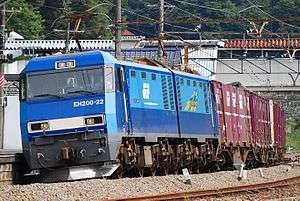JR Freight Class EH200
The Class EH200 (EH200形) is a Bo′Bo′+Bo′Bo′ wheel arrangement twin unit DC electric freight locomotive operated by JR Freight in Japan since 2001.[1][2]
| Class EH200 | |||||||||||||||||||||||
|---|---|---|---|---|---|---|---|---|---|---|---|---|---|---|---|---|---|---|---|---|---|---|---|
 EH200-22 on the Chuo Main Line in October 2010 | |||||||||||||||||||||||
| |||||||||||||||||||||||
| |||||||||||||||||||||||
| |||||||||||||||||||||||
| |||||||||||||||||||||||
Operations
The locomotives are built at the Toshiba factory in Fuchū, Tokyo. They are all based at Takasaki depot, and are primarily used on oil tank trains north of Tokyo and on the steeply-graded Chūō Main Line, Shinonoi Line, and Joetsu Line, replacing pairs of Class EF64s.[3]
As of 1 March 2017, 25 Class EH200 locomotives are in service (EH200-901 and EH200-1 to EH200-24).[4]
Variants
- EH200-900: Prototype locomotive EH200-901, built 2001
- EH200-0: Full-production locomotives built from 2003 onward
EH200-901 prototype
The pre-production prototype, EH200-901, was delivered to Takasaki depot in 2001, and entered revenue service in October 2002 following extensive testing.
- Prototype EH200-901 at Hachiōji station in September 2003
EH200-0 full-production version
Following evaluation of the prototype version, the first full-production locomotive, EH200-1, was delivered to Takasaki in March 2003.[2] A number of minor improvements were incorporated, with the main external differences from the prototype being as follows.[2]
- Elimination of centre pillar in the cab windscreens
- Redesigned windscreen wipers
- "Blue Thunder" logo on bodyside
- Reduced size white "JRF" logo on the body side
- EH200-21 in September 2010
 Side view of EH200-8 in May 2010
Side view of EH200-8 in May 2010
Classification
The EH200 classification for this locomotive type is explained below. As with previous locomotive designs, the prototype is numbered EH200-901, with subsequent production locomotives numbered from EH200-1 onward.
- E: Electric locomotive
- H: Eight driving axles
- 200: DC locomotive with AC motors
References
| Wikimedia Commons has media related to JR Freight EH200. |
- Jr機関車カタログ: Jr7社の現有30形式を詳しく解說 JR機関車カタログ [JR Locomotive Catalogue]. Japan: Ikaros Publications Ltd. 20 June 2013. pp. 48–50. ISBN 9784863207271.
- Jēāru zensharyō handobukku: Rail Magazine 2009 JR全車輌ハンドブック2009 [JR Rolling Stock Handbook 2009]. Japan: Neko Publishing. 2009. p. 42. ISBN 978-4-7770-0836-0.
- ELダイヤ情報21 [Electric Loco Timetable Information 21]. Tokyo, Japan: Kotsu Shimbunsha. October 2012. pp. 36–37. ISBN 978-4330320120.
- Kisumi, Kenzo (April 2017). 世代交代が進むJR貨物の機関車 [Advances in handover between generations for JR Freight locomotives]. Tetsudo Club (in Japanese). Vol. 2. Japan: Cosmic Publishing. p. 98. ISBN 978-4-7747-8338-3.